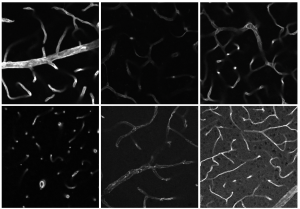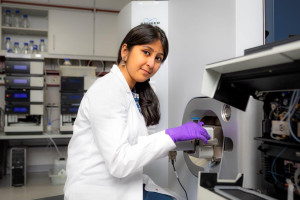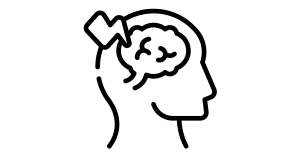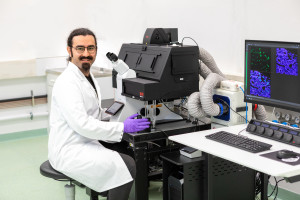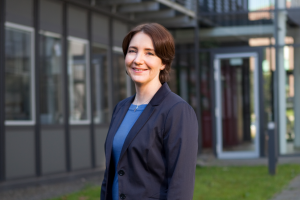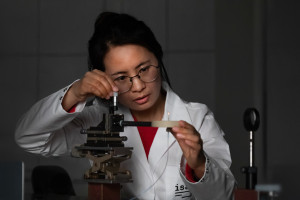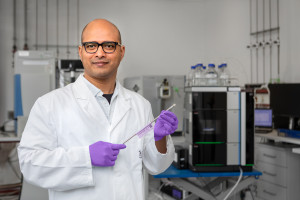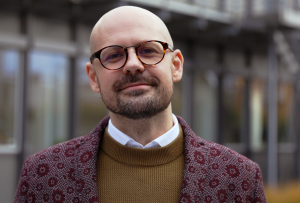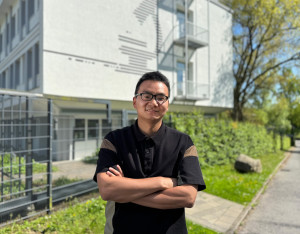Dortmund, 11th June 2025
Lennart Oberscheidt is a research associate and visual effects (VFX) supervisor at storyLab kiU, the digital research and presentation centre of the Dortmund University of Applied Sciences and Arts. Here, the 38-year old focuses on current issues relating to digital society. These include, for example, new narrative strategies in combination with innovative technologies and forms of presentation. In the ISAS cooperation project “The Secret World of the Immune System”, Oberscheidt and the team led by artistic director Harald Opel incorporated microscope data from ISAS into an experience in an immersive space for the first time. In this interview, he talks about the special features of the project and the similarities between art and research.
What is the immersive space at storyLab kiU and what is the goal behind it?
Oberscheidt: Our immersive space at the Dortmunder U consists of four walls on which images are displayed all around using high-performance projectors. A tracking system records the positions of the person so that the three-dimensional world of image and sound changes with the correct perspective as the person moves. It's a bit like virtual reality or VR glasses – but without the glasses.
The space was created as part of our Page 21 project funded by the Ministry of Culture and Science of North Rhine-Westphalia. The idea behind it was to create a virtual environment from the works of art in Dortmund's museums and make it possible for visitors to experience them. To do this we explore storytelling in various new media – both practically and from a research perspective. The aspiration to create completely new narrative worlds is a common thread through all our work at storyLab kiU: whether it's façade mapping or, for example, the cooperation project with ISAS.
It was the first time your team had worked with scientific research data. Was there anything special or were there surprises?
Oberscheidt: Simply the fact that the structures on the images are so incredibly small is totally crazy. Taking something that was previously only visible under a microscope or on a screen and allowing people to experience it, as if they were part of it, was completely new for us. Especially at the beginning, we literally had to find our way around the data and understand what was relevant from a biological perspective for the story we wanted to bring to life with ISAS. To do this, we had a lot of discussions with the communicators, asked the researchers lots of questions and visited one another. Particularly for the students for whom our projects provide an opportunity to use and expand their skills under real conditions, visiting the laboratory was something special.

Lennart Oberscheidt worked as an artist on the cooperation project between Dortmund University of Applied Sciences and Arts and ISAS.
© Privat
We quickly found common ground from a technical perspective. Just like the researchers at ISAS, we build up our 3D models from different layers. How many layers are there and how far apart are they? How can we convert this data into a volume model? We essentially ask ourselves the same questions during our work.
How did you manage to mix artistic storytelling with research data for the experience?
Oberscheidt: Art thrives on fantastic, i.e. unreal, stories that someone has made up. But almost every story has a kernel of truth in it somewhere. The difference when working on scientific topics is that this fact-based core always has to be retained. Myocardial infarction or heart attack is a topic that affects a lot of people and is very present in society. For the Dortmund Science Night we therefore wanted to create a narrative that accurately depicts the scientific facts and provides an accurate insight into the previously unknown research into new therapies.
At the same time, the aim is to create something aesthetically appealing that involves the audience, because simply presenting a collection of scientific facts could quickly become overwhelming – you have to keep a balance. During the course of the project, we gradually worked towards this both visually and through the sound design. In the end we were able to create an experience together that was as entertaining as possible, but still naturally exciting and visually impressive.
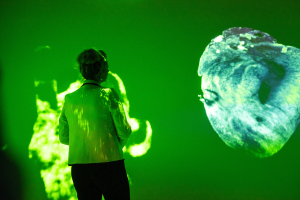
Ina Brandes, Minister for Culture and Science of the State of North Rhine-Westphalia, also came to the Science Night 2024 to see the immersive experience for herself. In the picture, she is looking at an image of an infarct heart taken using light sheet fluorescence microscopy.
© Stadt Dortmund / Roland Baege
The installation was created for the Dortmund Science Night 2024. How can anyone who is interested view the immersive experience now?
The immersive space is open to the public on Saturdays and Sundays. Anyone who is interested can simply drop by at the Dortmunder U and experience one of the many narrative worlds for themselves. Whether you then find yourself in the microscope images from ISAS or in a work of art from the Dortmund museums is pure chance.
(Interview by Cheyenne Peters.)
